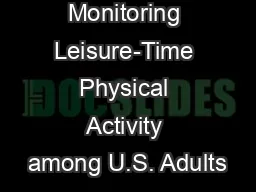

Charlotte A Schoenborn Division of Health Interview Statistics National Center for Health Statistics Centers for Disease Control and Prevention The findings and conclusions in this presentation are those of the authors and do not necessarily ID: 462288
Download Presentation The PPT/PDF document "Monitoring Leisure-Time Physical Activit..." is the property of its rightful owner. Permission is granted to download and print the materials on this web site for personal, non-commercial use only, and to display it on your personal computer provided you do not modify the materials and that you retain all copyright notices contained in the materials. By downloading content from our website, you accept the terms of this agreement.
Slide1
Monitoring Leisure-Time Physical Activity among U.S. Adults
Charlotte A. Schoenborn
Division of Health Interview Statistics
National Center for Health Statistics
Centers for Disease Control and Prevention
The findings and conclusions in this presentation are those of the authors and do not necessarily
represent the official position of the Centers for Disease Control and Prevention
.Slide2
Co-authors
Susan Carlson
Janet Fulton
Fleetwood Loustalot
National Center for Chronic Disease Prevention and Health Promotion, CDC
2Slide3
NHIS Leisure-time Physical Activity
Collected periodically since 1975 and annually since 1997.
Monitors progress toward National Healthy People (HP) Objectives.
LTPA indicators will change with move from HP 2010 to HP 2020.
3Slide4
New Directions
New Physical Activity Guidelines issued in 2008
Based on comprehensive review of scientific evidence
4Slide5
NHIS Adult
Physical Activity Indicators
Healthy People 2010
(2000-2009)
2008 PA Guidelines (2010 - forward)5Slide6
What is new about the 2008 Physical Activity Guidelines ?
Definition of “aerobically active”
Additional guidelines:
Highly active level
Combined muscle-strengthening AND aerobic activity
6Slide7
Does the transition to the 2008 Guidelines
influence surveillance?
Prevalence estimates?
Socio-demographic variations?
Trends?
7Slide8
The Changing Definition of
Aerobically Active for Adults
Healthy People 2010
criteria
2008 Guidelines
criteria
Intensity
Moderate
Vigorous
Moderate
Vigorous
Equivalent
Combination
Duration
(min/day)
≥ 30
≥ 20
Frequency
(days/week)
5
3
Volume
(min/week)≥ 150≥ 75≥ 150
8Slide9
Prevalence of being aerobically
active:
Healthy People
2010 versus 2008 Guidelines,NHIS, 2009
Healthy People 2010
criteria
2008 Guidelines
criteria
%
95% CI
%
95% CI
34.9
34.0, 35.8
47.2
46.2, 48.2
Source: National Health Interview Survey, Sample Adult Component, 2009. Unpublished data.
9Slide10
Comparing Healthy People 2010 and
2008 Guidelines criteria for aerobic activity,
by sex and age: NHIS 2009
Sex
Age group
10Slide11
Comparing Healthy People 2010 and
2008 Guidelines criteria for aerobic activity,
by race/ethnicity and education: NHIS 2009
Race/ethnicity
Education level
11Slide12
Trends in aerobic activity 1998-2009:
Healthy People 2010
versus
2008 Guidelines
12
Source: CDC/NCHS: National Health Interview SurveySlide13
Highly Active Level
Level new with 2008 Guidelines
Aerobic physical activity for:
> 300 min/week moderate-intensity> 150 min/week vigorous-intensityEquivalent combination
13Slide14
Prevalence of aerobic physical activity in four levels, NHIS 2009
Active
Highly active (>300 min/wk moderate-intensity activity, >150 min/wk vigorous-intensity activity, or equivalent combination), sufficiently active (150-300 min/wk moderate-intensity activity, 75-150 min/wk vigorous-intensity activity, or equivalent combination), insufficiently active (some activity but not enough to meet active definition), and inactive (no activity of at least 10 min/time).
14Slide15
Percentage of adults who were highly active according to the 2008 Guidelines:
NHIS 2009
Sex
15Slide16
Muscle-strengthening and aerobic activity
HP 2010: Separate muscle-strengthening objective
2008 Guidelines:
Combine muscle-strengthening with aerobic activity
16Slide17
Percentage of adults who met the muscle-strengthening and aerobic guideline, NHIS 2009
Active
17Slide18
Percentage of adults who met the full 2008 Guidelines (aerobic + strength) by selected characteristics, NHIS 2009
Sex
18Slide19
Trends in meeting 2008 Aerobic PA Guideline
among U.S. adults, by sex: 2007-2009
Source: CDC/NCHS: National Health Interview Survey
,
19Slide20
Trends in meeting
2008 Aerobic PA Guideline among U.S. adults, by age: 2007-2009
Source: CDC/NCHS: National Health Interview Survey
,
20Slide21
Trends in meeting 2008 Aerobic PA Guideline among U.S. adults, by race/ethnicity: 2007-2009
Source: CDC/NCHS: National Health Interview Survey
,
21Slide22
Trends in meeting PA 2008 Aerobic PA Guideline
among U.S. adults, by education
: 2007-2009
Source: CDC/NCHS: National Health Interview Survey
,
22Slide23
Conclusions
Compared with HP 2010 criteria, prevalence estimates shifted to upward by more than 10 percentage points when 2008 Guidelines were applied.
Disparities and trends over time were similar regardless of the LTPA criteria.
Leisure-time physical activity prevalence at recommended levels has increased modestly in recent years.
23Slide24
For Further Information
NHIS Physical Activity Information Website:
http://
www.cdc.gov/nchs/nhis/physical_activity.htm
NHIS listserve: nhislist@cdc.gov
For questions about this presentation, feel free to contact me at:
CSchoenborn@cdc.gov
Thank you!
24